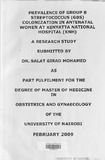| dc.contributor.author | Mohamed, Salat G | |
| dc.date.accessioned | 2013-05-24T06:15:41Z | |
| dc.date.available | 2013-05-24T06:15:41Z | |
| dc.date.issued | 2009 | |
| dc.identifier.citation | Master of medicine in obstetrics and gynaecology | en |
| dc.identifier.uri | http://erepository.uonbi.ac.ke:8080/xmlui/handle/11295/25068 | |
| dc.description.abstract | Background Group B streptococcus (GBS; Streptococcus agalactiae) is a
gram-positive coccus and approximately 10-30% of women worldwide carry it
in their urogenital or lower gastrointestinal tract. It is a leading cause of
perinatal morbidity and mortality and a common cause of maternal peripartal
infections in some developed countries. In Kenya, however, the spectrum of
GBS disease remains a largely under-recognised problem. Prophylactic
treatment is easily achieved with penicillin G which is accessible at low cost at
Kenyatta National Hospital (KNH) with excellent gains In neonatal and
maternal health.
Objective: To determine the prevalence of GBS among antenatal women at
KNH and assess associated risk factors.
Study Deign: A cross-sectional descriptive study.
Setting: KNH antenatal clinic.
Study Population: Pregnant women attending the antenatal clinic at KNH.
Methodology: A total of 322 consenting pregnant women >35 weeks
gestation by dates with no history of antibiotic use within the, two weeks prior
to the study and no current per vaginal bleeding were recruited into the
study. Swabs for culture of group B streptococcus (GBS) were obtained from
the lower vagina and the anorectal canal. A second smear was taken from the
walls of the lower vagina for microscopic examination of bacterial vaginosis.
Antenatal profile data such as HIV, VDRL, and HB were extracted from
patients' files. Data entry and analysis was carried out using EPI-Info 3.3 and
SPSS Version 13 respectively. A p-value of less than 0.05 was considered
statistically significant.
Results
The mean age of the mothers was 28.2 (+5) with a range of 18 to 45 years.
Majority of the women were married (90.3%), had at least secondary level of
education (81%) and were employed (62.3%). Slightly over 60% were
multigravid. About 29% of those who were multi-gravid reported history of
still birth. GBS was isolated in 81 (25.2%) of the participants. The anorectal
colonization was greater (21.2%) than vaginal colonization (14%), however,
isolation of GBS in the vaginal cavity was significantly associated with
isolation in the anorectal canal, p= <0.0001. GBS colonization was
significantly associated with History of still birth, (p = 0.011). No significant
association was found between GBS colonization and age, parity, employment
and level of education. Similarly no significant association was found between
GBS colonization and HIV status, bacterial vaginosis, and history of other bad
pregnancy outcomes such as preterm delivery, early neonatal death, early
neonatal sepsis, premature rupture of membranes (PROM) and fever in
previous pregnancy.
Conclusions and recommendations
A quarter of the mothers attending antenatal clinic at KNH are GBS colonized
a figure that is comparable to findings in other parts of the world. GBS
colonization is significantly associated with history of still birth. We therefore
advocate for access to GBS screening for high risk mothers in our unit. We
recommend a follow up study to determine the impact of GBS colonization on
maternal and perinatal morbidity and mortality and the cost effectiveness of
universal antenatal screening in our set-up. | en |
| dc.description.sponsorship | University of Nairobi | en |
| dc.language.iso | en | en |
| dc.title | Prevalence of group B Streptococcus (GBS) Colonization in antenatal Women at Kenyatta national Hospital (KNH) | en |
| dc.type | Thesis | en |
| dc.description.department | a
Department of Psychiatry, University of Nairobi, ; bDepartment of Mental Health, School of Medicine,
Moi University, Eldoret, Kenya | |
| local.publisher | Department of Paediatrics, College of Health Sciences, University of Nairobi, Kenya | en |

